-
 14187 Hits
14187 Hits
-
 84.27% Score
84.27% Score
-
 18 Votes
18 Votes
|
|
Route |
|---|---|
|
|
46.15478°N / 10.89794°E |
|
|
Trad Climbing |
|
|
Summer |
|
|
Most of a day |
|
|
IV |
|
|
Overview
Campanile Basso di Brenta Normal Route
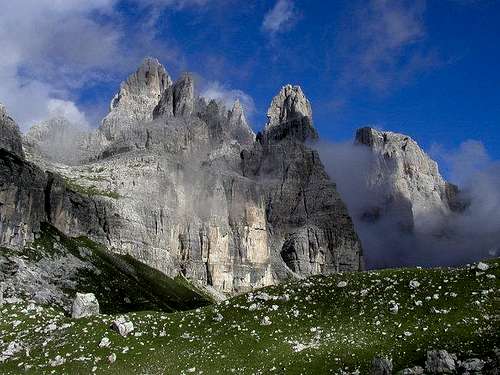
Campanile Basso di Brenta 2877 m is a beautiful spire rising vertically towards the sky between the Brenta Alta and the Campanile Alto in the Sfulmini chain, Brenta Dolomites.
It's the most famous steeple of the Brenta group and even of the whole Dolomites. Not only! The Campanile Basso in reason of its particularly soaring and daring shape is considered as one of the finest spires in the world.
It has a very smart structure: a slender cylindrical pinnacle with a big shoulder on its Westside. Combining a route to the shoulder with a route to the higher part you can climb for over 500 m drop.
Formerly known (only by the Germans) as the Guglia di Brenta, it was first climbed in the year 1899 by two students from Innsbruck, Otto Ampferer and Karl Berger. Due to its beauty and the surrounding environment, the Campanile Basso is a mountain that fascinates and still attracts many climbers to over a century from the first ascent.
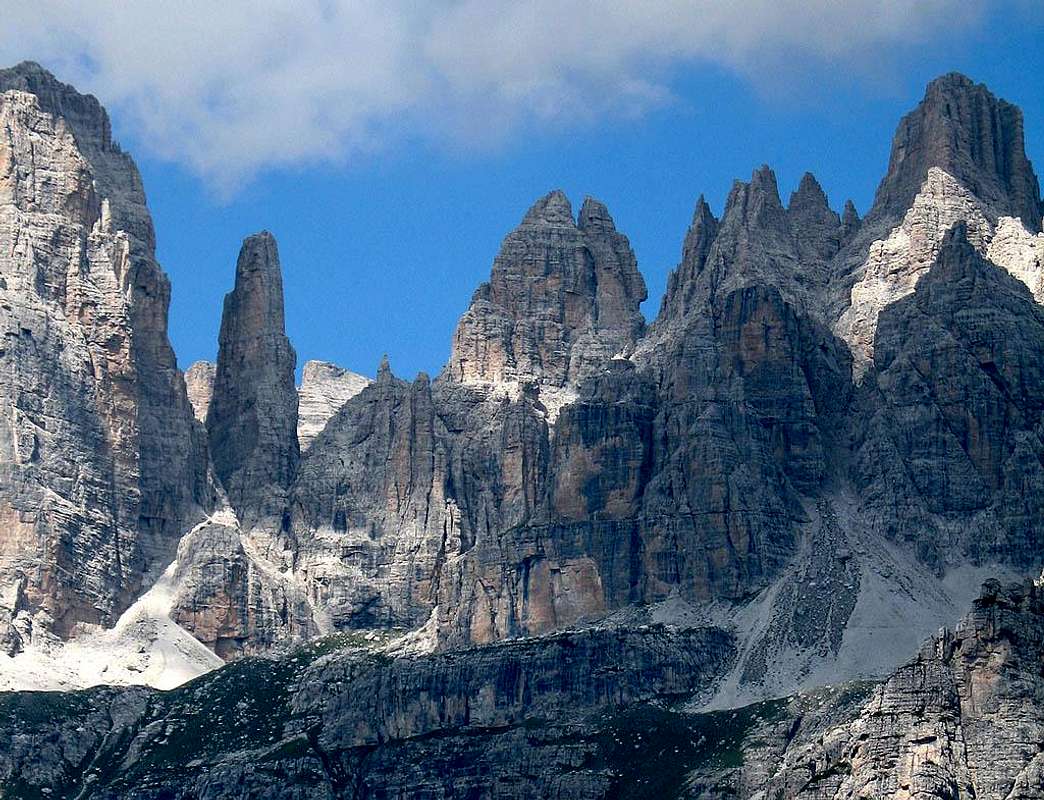
There are no easy routes, even the Normal Route which follows the itinerary of the first summiters involves a climb up to the IV degree UIAA. Also the descent requires a good skill as you have to do a series of not easy abseils.

History
Getting There
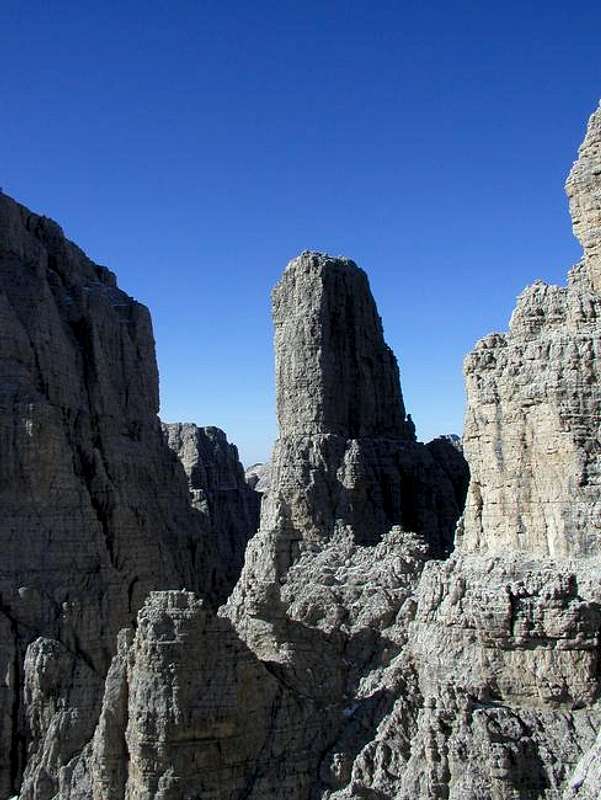
The starting point to approach Campanile Basso is Madonna di Campiglio (TN) 1514 m, in upper Val Rendena. From here you must reach Vallesinella. By walk to the rifugio Brentei or alternatively the Rifugio Pedrotti.
Road access to Madonna di Campiglio m. 1514
- Coming from A22 Brennero Motorway (direction towards South) exit Trento Centro, then follow the SS 45 towards Riva del Garda and Tione, getting to the village Le Sarche. From here take the SS 237 reaching Ponte Arche and Tione. In Tione turn to right and follow the Val Rendena road getting to Pinzolo and Madonna di Campiglio.
- Coming from A22 Brennero Motorway (direction towards North) exit San Michele Mezzocorona, then take the Val di Non road, getting to Cles, Malé and Dimaro. In Dimaro leave the main road and turn to left on the Val Meledrio road, reaching Folgarida, Passo Campo Carlo Magno and Madonna di Campiglio.
Road access to Vallesinella
From Madonna di Campiglio m. 1514 a level road reachs the parking of Vallesinella (4 km. From Madonna di Campiglio). Pay attention: on Sundays from June 15th to September 21th, from 9.45 to 18.15, and all the days from June 28th to August 31th, same time-table, the road is closed to the private cars. In these periods a minibus-service starting from Madonna di Campiglio is available. In the same period paying parking in Vallesinella (5 euro). By walking in 45 minutes.
Walking approach to Rifugio Brentei
From Vallesinella on foot by the path 317 to Rifugio Casinei and then path 318 (Sentiero Bogani) to the Rifugio Brentei - in 1 more hour, along the wonderful path of the Bocca di Brenta you can get the Rifugio Pedrotti.
Route Description
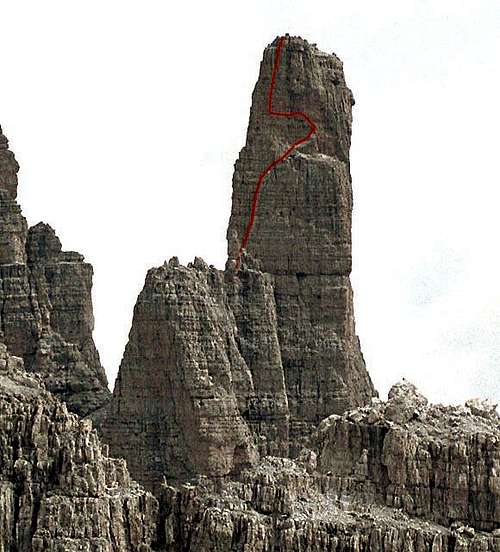
Campanile Basso Normal route (UIAA scale)
Summit altitude: 2877 m
Difficulty: IV
Climbing length: 270 m
Equipment: equipped belays, pegs along the pitches
Starting point: Rifugio Brentei - Rifugio Pedrotti
Approach - From the Refuge Brentei take the path towards the Bocca di Brenta, passing in the upper part some rock outcrops aided by some iron ropes and some snowfields at the beginning of the season. Before reaching the Bocca di Brenta turn to left and go up to take the Via Ferrata delle Bocchette Centrali.
Follow it up to the Bocchetta del Campanile Basso, where you leave the Sentiero delle Bocchette descending a few meters down to the left, then climb up on some steps to the base of the South-East wall, looking for the easiest passages up to a debris shelf where you will find the first equipped belay on the via Normale (anchors).
Route report
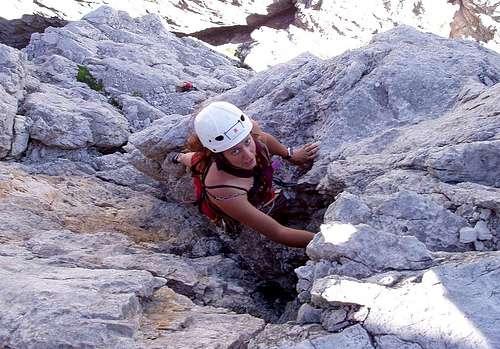
L1 - Climb the steps slightly to the left reaching the base of a chimney slanting right. Follow it to its end, reaching a comfortable equipped belay at the base of the yellow Pooli wall, III+, 50 m, 1 peg
L2 - Climb the wall vertically reaching a frame through which traverse for 5 meters to the right reaching a small terrace on the edge between the South and East walls, IV+, IV, 30 m, 5 pegs
L3 - Go around the edge to the right and then climb vertically up to a ledge (on the left visible equipped belay which will be used downhill). Follow the ledge easily to the right for about 10 meters. Belay to be equipped on an outcrop, III+, III-. 35 m
L4 - Climb slanting right, passing easy rocks and ledges. Equipped belay on a wide ledge below the vertical of the "Y" chimneys, II, 40 m, 1 peg.
L5 - Straight up the wall above to reach the base of two divergent chimneys (the "Y" chimneys), where there is an equipped belay, III, 20 m.
L6 - Climb the left chimney. After 20 meters the chimney ends and there is a belay on a ring; continue further, slanting left on easy rocks, to a large ledge, the famous "Stradone Provinciale". On the left, near the NE ridge, there is a good equipped belay, 45 Mt., IV-, III, 45 m, 1 peg, 1 intermediate belay.
L7 - The wide ledge runs across the north face of the Campanile Basso. Follow entirely the "Stradone Provinciale" in the right direction, turning around the spire and passing the NW ridge, reaching the W shoulder and belay under an inclined dihedral, I, II, 100 m.
L8 - Climb entirely the dihedral-chimney up to the belay on a small pulpit, located under a large terrace called "Albergo al Sole" (this terrace is above, do not reach it), IV, 60 m, 2 peg, possible an intermediate belay.
L9 - Climb on the left wall towards the NE edge until you reach a very small terrace just on the edge, called the "Terrazzino del Re del Belgio", where there is the belay, IV, 40 m
L10 - From the small terrace turn left behind the sharp edge and pass on the vertical North wall. Traverse to the left on a corniche. Ignore the first crack with a visible peg and continue the traverse the corniche widens. Belay at the base of the famous Ampferer wall, III, 10 m, 1 peg.
L11 - From the left head towards the overhang above the belay, without reaching it. Avoid it to the left. At this point it is possible to climb directly following a crack up to a few meters below the summit and belay here or go back to the right to the ridge belay here and then, with a further short and easy length, climb up to the summit, a broad plateau 15-20 meters wide where there is a historic tubular bell, IV, 45 m, 4 pegs.
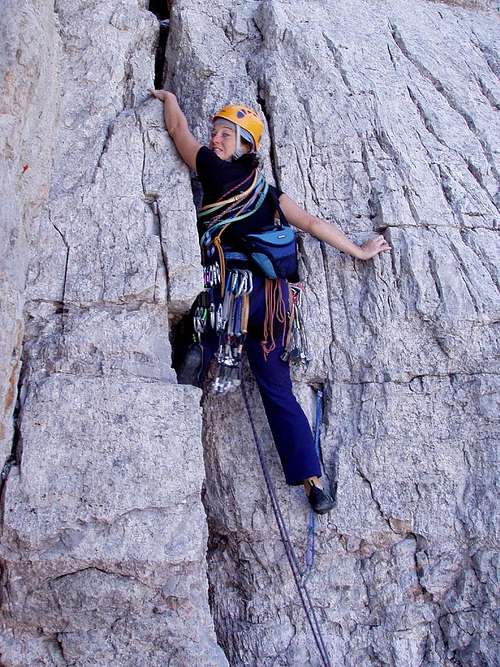
Descent: the descent route follows the ascent one. The anchors are placed in an optimal manner. From the summit with 2 abseils of 55 m reach the "Stradone Provinciale" (it is advisable to make 4 short abseils instead of 2 to prevent the rope from getting jammed). Run the entire ledge to the left (facing in) until the next anchor.
5th abseil (40 m): leads down from the main road.
6th descent (25 m): down to the ledge. Go along the ledge to the left (facing inside) for 15 meters until you reach another equipped belay on the small terrace above the Pooli wall.
7th descent (40 m): reaching the base of the Pooli wall.
8th descent (40 m): at the large terrace where it starts the route.
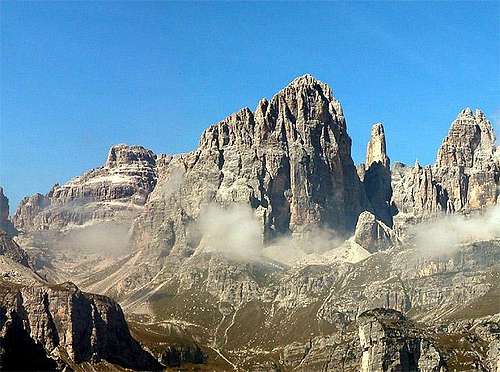
Essential Gear
Full rack and two 50m ropes. There are pegs in place on the most difficult sections and belays are equipped with ring bolts (also used for abseiling).
Red Tape
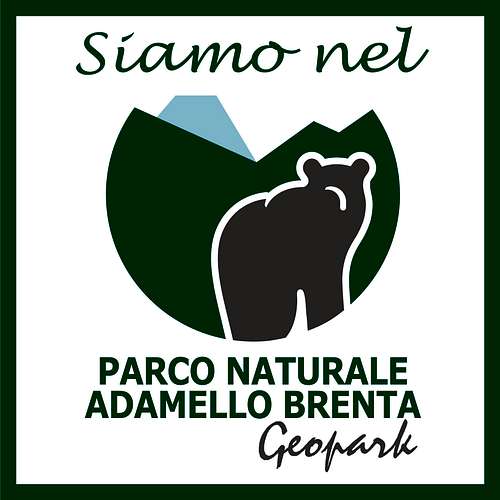
No permits no fees required. Campanile Basso is part of Adamello-Brenta Natural Park, the largest protected area in Trentino, established in the year 1967. It's located in Western Trentino and with its 620.51 square kilometers includes the mountain groups of Adamello, Presanella and Brenta Dolomites, separated by Val Rendena.
Follow the "leave no trace" approach. The whole Brenta Dolomites area had been acknowledged inside the Unesco World Heritage and deserves the best care and respect.
More info on SP about "Dolomites Unesco World Heritage" here in my dedicated article: Dolomites living mountains
Huts
Rifugio Brentei
Rifugio Pedrotti
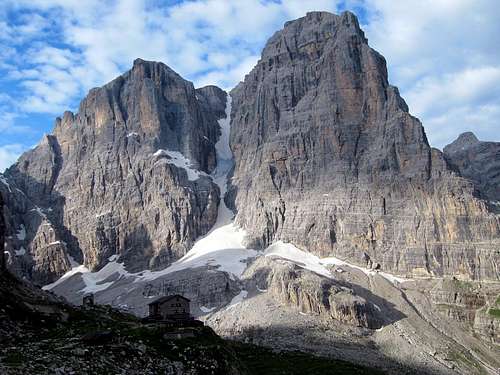
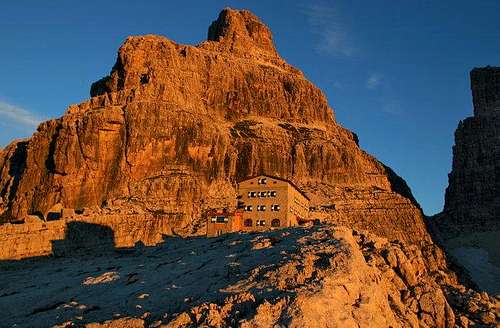
Other accomodation
Camping is available in S. Antonio di Mavignola (Campeggio Faè, +39-0465-507178). Place for motorhomes and campers near the cable-car starting point in Campo Carlo Magno. Unauthorized camping and wild camping are not normally allowed ... but near the Brentei none will tell you anything if you place a tent to spend the night; the refuge is much more comfortable and not expensive, but often full.
When to climb
The best period is the summer season
Meteo
Guidebooks and maps
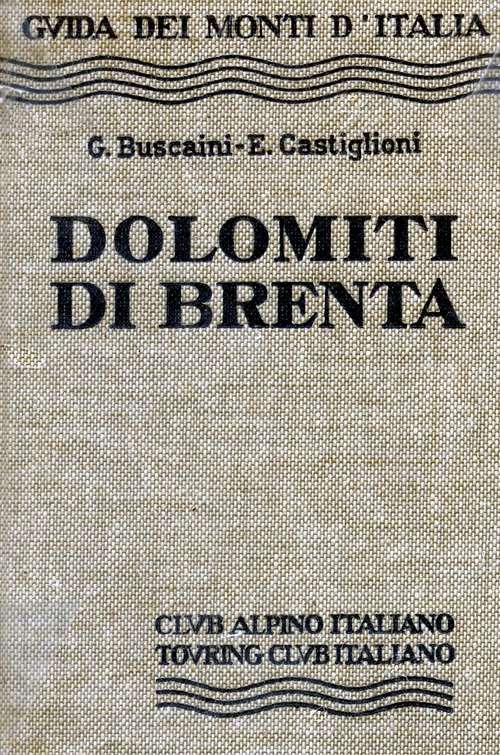
"Dolomiti di Brenta" - Gino Buscaini - Guide dei Monti d'Italia CAI-TCI


